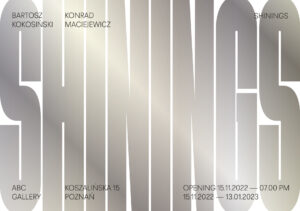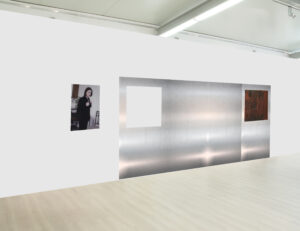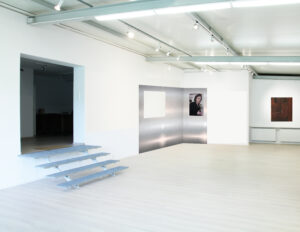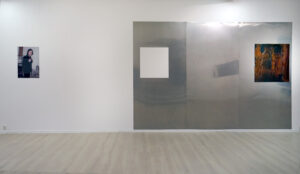
The project brings together explorations by two artists. Their common denominator is the metaphorical meaning of phenomena such as shining, mirroring and image multiplication. The authors intend their exhibition to generate that disturbing kind of shining experienced by Danny from Kubrick’s iconic horror movie, to which the project’s title refers. In the film, it was a moment of interpenetration of worlds, revealing what was deeply hidden. In July this year, the first instalment of The Shinings took place at the Inne Towarzystwo Gallery; the exhibition at ABC Gallery has been expanded to include additional paintings/objects.
Although each artist uses radically different means of expression, the works of both evoke similar emotional states in their viewers. The collages of Konrad Maciejewicz often deal with themes of death and the start of a new life. The artist cuts up existing cultural footage by using fragments of photographs from old magazines and juxtaposing them with pictures taken from the Internet. He truncates the human body, objects and architecture in order to assemble the whole into a new quality; the resultant complex symbolism is palimpsestic in nature. Maciejewicz’s works induce in the viewer a sense of curiosity mixed with awe, an effect characteristic of horror movies. The artist’s works can be interpreted in existential terms, as a metaphor for the terror of the individual alienated from the world, or of the alienated body. For The Shinings project, K. Maciejewicz has prepared a new set of works: print-outs on glass (portrait photographs and collages) and objects made from door leaves. In addition to their fairly obvious funerary associations, they connote transgression and entry into a different dimension.
Bartosz Kokosiński is recognised as an artist who primarily reflects on the phenomenon of painting. He is not interested in its illustrative aspect, but in the painting process itself, in the physicality of the matter from which the image is created. Therefore, he engages in a discourse with its conventions, often crossing the boundaries of painting and moving towards objects and installations. Kokosiński has created unique, recognisable and innovative formal strategies that are useful tools for reflecting on the status of painting and, indirectly, on the condition of contemporary humankind. The artist asks questions about the relationship between art and extra-artistic reality, embracing concepts such as hybrid, excess or overproduction. Kokosiński deforms his paintings, bending their structure, turning the canvases inside out and forcing various objects into them. His most recent series of works, some of which were created especially for the exhibition at ABC Gallery, are paintings either entirely or partially encased in resins. The shiny, transparent or semi-transparent resins act as double mirrors. They partially reveal what is “hidden” underneath, on the surface of the canvas, while simultaneously reflecting the surroundings: the architecture of the gallery, fragments of the exhibition, the image of the closest standing “viewer” and the other viewers. The artist often “smashes” his resin paintings-mirrors, additionally fragmenting the reflected image.
Kokosiński’s resin paintings in tandem with Maciejewicz’s portraits of the girl in the print-outs become corporeal. They seem to be gazing at the viewer, like her. The resin reciprocates the viewer’s gaze, but there is also something dead and funerary in its viscosity. It is like the remains of someone, a trace or a secretion. The brightly lit resin fragments reflect the light and dazzle, further complicating the image of the whole. The works by two artists overlap, appearing like echoes, intensifying the obsessive dark mood, creating a kind of visual labyrinth of mirrored and deformed images, images within images.
The mirror, the crooked or cracked/broken one, has extensive cultural connotations. For centuries, mirrors have been seen as magical objects, as conduits for crossing the line towards another dimension or making contact with the land of death. They are a symbol of truth, of a pure soul, of clarity of mind. They were believed to have a strong connection with the magic of the Sun and the Moon. They were an attribute of Aphrodite; sorcerers and magicians used their power to do magic, foretell the future and uncover the secrets of the past. When the path to the afterlife is opened before the soul of the deceased, the power of mirrors grows more intense. They were therefore turned upside down or screened to avoid seeing something not meant to be seen by the eyes of the living. One can fall in love in one’s own mirror reflection and turn into a flower (like Narcissus) or die because of it (like the basilisk). A vampire (who has no reflection) can still be recognised by means of a mirror. In the folk beliefs of Western Europe, mirrors were considered to be ominous objects that could accumulate both good and bad energy, the latter being insidiously transferred onto subsequent owners. Indian tribes of the Americas avoided mirrors in the belief that they have the power to seize human souls.
Nowadays, a mirror, especially a cracked or distorted one, which as in the case of The Shinings exhibition gives the effect of a multiplied or fragmented reflection, is associated with confusion, the inability to distinguish unequivocally between reality and its image. Uncertainty about the verifiability of our perception of the world, a split, or perhaps even a multiplication of the self, caused by an excess of images generated by contemporary culture, are the sensations and reflections evoked by Kokosiński and Maciejewicz’s exhibition. The Shinings is a peculiar study of madness, a poignant story about the isolation and loneliness of human beings trapped within the images of the world and their own, which self-multiply and, deformed, reproduce ad infinitum.







